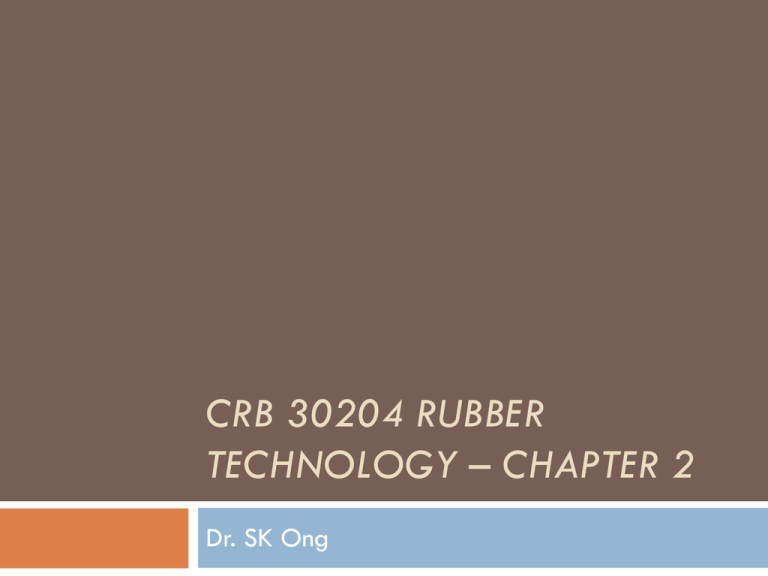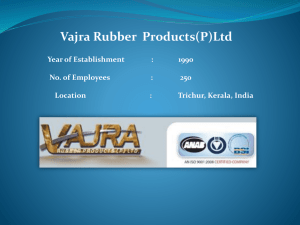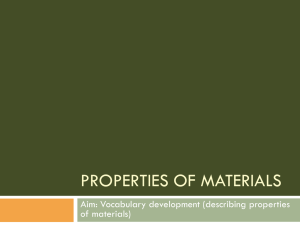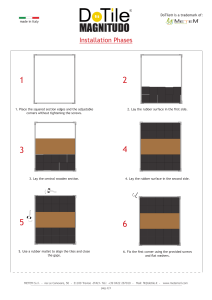CRB 30204 Rubber Technology – Chapter 3
advertisement

CRB 30204 RUBBER TECHNOLOGY – CHAPTER 2 Dr. SK Ong Chapter Outline Rubber Additives Compounding ingredient Vulcanization systems Rubber reinforcement theories Dr. Ong SK 2 Raw Rubber Processing Testing: Viscosity/Plasticity Raw rubber Mastication Tool: Two-roll mill or internal mixer Compounding Testing: Scorch & Cure Characteristic Rubber compound Shaping Vulcanization Testing: Tensile Test, Tear Strength, Compression Set, Abrasion, Resilience, Hardness, Ageing etc Tool: Calendering, spreading, extruding, compression moulding, transfer moulding, injection moulding Final product Dr. Ong SK 3 Viscosity Test – Mooney Viscometer Equipment: Mooney Viscometer Properties measured: viscosity of raw rubber (incoming rubber bale) Unit : Mooney units Standards: IS0 289, ASTM D 1646, BS 903: Part A58, DIN 53523-3 Dr. Ong SK 4 How Mooney Viscometer Works? A knurled knob (rotor) rotates (at 2 revolutions/min) in a closed heated cavity (like a mold), filled with uncured rubber. Shearing action will develops btwn compound & rotor when the rotor rotate This results in torque (resistance of the rubber to the turning rotor) Mooney units is directly relate to torque The higher the number, the higher the viscosity (higher resistance of the rubber against the rotor rotation) Dr. Ong SK 5 Schematic Diagram of Mooney Viscometer Dr. Ong SK 6 Mooney Viscosity Results Dr. Ong SK 7 Wallace Plastimeter Measures the plasticity or viscosity of cylindrically cut unvulcanized rubbers which is under a constant compressive force btwn 2 parallel plates Very simple & crude methods for measuring flow of rubber Disadvantages: operate at extremely low shear rate range (0.0025 to 1 s-1) Wallace Plastimeter (Cont’) Determine the Plasticity Retention Index (PRI) of raw natural rubbers (ASTM D 3194) PRI is a measure of the resistance of raw NR to oxidation. Oxidation effect is assessed by measuring the plasticity before ageing (P0) and after ageing for 30mins in the Wallace - MRPRA ageing oven at 140°C (P30) Wallace Plastimeter (Cont’) Tackiness (Rubber) Tackiness: ability of an uncured rubber compound to stick to itself or another compound in short dwell time with moderate applied pressure Important property when a rubber product was built by laying one calendered/extruded rubber ply on top of another Uncured layers must hv good tackiness prior to curing Tackiness can be deteriorate due to blooming of additives like sulfur, accelerators, waxes etc (tackifier can be added to improve this property) Tool: Tel-Tak Tackmeter (no ATSM/ISO test std) Mastication Entangled rubber chains are ‘torn apart’ at weakest bond Free radicals will recombine or add to a double bond in another rubber chain w/o O2 present. (rubber chain not permanently broken) With O2 present, peroxy radical formed. (permanent breakdown of rubber chain) Tool: Two-roll mill, internal mixer, injection molding etc Dr. Ong SK 12 Compounding/Mixing Obj: Obtain uniform blend with good dispersion of each ingredient Produce consistent batches which are uniform in viscosity & degree of dispersion. Main tools: Two-roll mill or internal mixer Main constituents: Rubber, antioxidant, accelerator, vulcanizing agent(s), activator, reinforcing agents/filler, processing aids, extender/diluents & pigments. Dr. Ong SK 13 Main Compounding Ingredients Rubber or blends of rubbers Vulcanizing agent(s) Accelerators of vulcanization Activators of accelerators Reinforcing agents or filler (carbon black, mineral filler) Processing aids (peptisers, plasticizers, dispersing aids) Extenders or diluents (extending oils, cheap inert mineral fillers) Pigments or colouring materials Antidegradants Dr. Ong SK 14 Example Dr. Ong SK 15 Accelerators Majority contains nitrogen or sulphur atoms Classified in term of cure rates or chemical structure Dr. Ong SK 16 Classification of Accelerators Dr. Ong SK 17 Classification of Accelerators (cont.) Dr. Ong SK 18 More Information on Selected Accelerators Accelerators Characteristics Dithiocarbamates Example: Zinc dibutyl dithiocarbamate (ZDBC). Very scorchy & very fast curing. Useful in low temperature (down to 100oC) vulcanization and in elastomers with low levels of unsaturation such as EPDM. Note that as temperature reduces scorch increases & cure rate decreases. Thiurams Example: Tetramethylthiuram disulfide (TMTD). Somewhat less scorchy than dithiocarbamates & fast curing. TMTD is less scorchy in the absence of sulfur. In this case its function would be that of a cross-linking agent rather than an accelerator. Tetramethylthiuram monosulfide (TMTM) gives good compression set. Dr. Ong SK 19 More Information on Selected Accelerators Accelerators Characteristics Thiazoles eg: Mercaptobenzothiazole (MBT). Moderate cure rate & scorch giving a low modulus vulcanizate. Guanidines eg: Diphenyl guanidine (DPG). Scorchy & slow curing. Most often used in combination with other accelerators. Sulfenamides eg: N-cyclohexyl-2-benzothiazolseu lfenamide (CBS). Long scorch with medium to fast cure. It would be a good choice when mixing compounds containing reinforcing furnace blacks which generate more heat. The sulfenamide N,N-dicyclohexyl-2-benzothiazyl sulfenamide (DCBS) gives longer scorch & slower curing. DCBS gives excellent adhesion when bonding brass 20 coated steel to rubber, Dr. egOng in SK tire production. Examples of Accelerators & Its Structure Dr. Ong SK 21 Examples of Accelerators & Its Structure Dr. Ong SK 22 Vulcanization characteristics by various accelerators and combinations. Dr. Ong SK 23 Various Accelerators & Its Cure Time Dr. Ong SK 24 Activator Increase vulcanization rate by activating the accelerator Types of activators Inorganic compounds, mainly metal oxides e.g. Zinc oxide 3-5 p.h.r. Organic acids, high molecular weight monobasic fatty acids e.g. stearic acid 1-3 p.h.r. Alkaline substances, mainly amines e.g. diethanolamine 2 p.h.r. used in silica-filled compounds, and compounds with acidic ingredients) Normally ZnO & stearic acid are used together or zinc stearate to replace both Zinc oxide reacts with stearic acid to form zinc stearate Together w/accelerator they speed up the rate at which sulfur vulcanization occurs. With sulfur alone, the curing process might take hours. With this curing system, it can be reduced to minutes. Dr. Ong SK 25 Vulcanizing Agents – Sulfur It reacts chemically with the raw gum elastomer forming cross-links between the polymer chains, resulting in a more dimensionally stable and less heat-sensitive product. Elastomers need to hv unsaturated bonds Its cost is relatively low but its function is essential. Grade for rubber application: cyclic sulfur in fine rhombic crystal shape (S8) /amorphous sulfur At high sulfur level in a compound, it can slowly bloom to the surface. Sulfur donor like TMTD/TETD can be use also Dr. Ong SK 26 Chemistry of Sulfur Vulcanization Refer to Handouts Dr. Ong SK 27 Sulfur Vulcanization System Cure systems (phr) Accelerator (phr) Conventional 2.0 - 3.5 1.0 - 0.4 EV 0.3 - 0.8 6.0 - 2.5 Semi-EV 1.0 - 1.7 2.5 - 1.0 Dr. Ong SK 28 Sulphur Vulcanizing System EV system: Mainly monosulphide cross-link Little modification except on pendant grps CV system: Mainly di-,poly- & cyclic sulphide cross-link Sulphide cross-link easily decompose & causing main chain modification Note: C-C bond: strong; C-S bond: medium strong: S-S bond: weak; S-Sx-S bond: weak Dr. Ong SK 29 Dr. Ong SK 30 Vulcanizing Agents – Peroxide Most common organic peroxide: dicumyl peroxide (DCP) Elastomer do not need unsaturated bonds Major curative for silicone rubber Note: not recommended for some elastomers such as IIR or CIIR Dr. Ong SK 31 Chemistry of Peroxide Curing Peroxide decomposition: abstraction of a hydrogen atom from an allylic position on the polymer addition of the peroxide-derived radical to a double bond of the polymer molecule Crosslinking of 2 polymeric free radicals Dr. Ong SK 32 Chemistry of Peroxide Curing (Cont.) Or addition of polymeric free radicals to double bonds Dr. Ong SK 33 Cares When Using Peroxide Reason: to avoid unwanted interaction with peroxide Example Antioxidant selection Contact with oxygen (air) should be avoided during vulcanization (such as in hot air ovens or autoclave curing). Some ingredients, which are not part of the cure system, which are common in sulfur systems can interact with the peroxide in peroxide cure systems and thus interfere with cure. Dr. Ong SK 34 Peroxides Cure Vulcanizate hv good resistance towards oxidative ageing & reversion due to stable C-C x/link Compression set is also improved Tensile strength, tear strength, and fatigue (dynamic deformation such as constant flexing) life are reduced. Dr. Ong SK 35 Peroxides Cure Post cure (continued cure outside of the mold) is sometimes undertaken with peroxide cured vulcanizates, to complete the cure and remove unwanted byproducts. x/link density of a peroxide cured compound can be increased by addition of chemicals called coagents, of which methacrylates are a good example. This results in a higher state of cure with improvements in properties such as compression set Dr. Ong SK 36 Dynamic Vulcanization For thermoplastic elastomer (TPE) Vulcanizing or x/linking of one polymer during its molten-state mixing with another polymer or with other polymers. The polymers are first thoroughly mixed and then, during further mixing, one of the polymers will x/linked, whereas the remaining other polymeric material remains uncrosslinked. The process produces a dispersion of x/linked polymer in a matrix or continuous phase of uncrosslinked polymer. Dr. Ong SK 37 Filler Function of fillers: Reinforcement effect, i.e. to increase mechanical properties (eg, TS & resistance to tearing) in the vulcanizate & to increase stiffness Compound cost reduction Might be for coloring purpose Types of filler Reinforcing filler (Carbon black & silica): To improve the mechanical properties of the filled rubber vulcanizate Non-reinforcing filler (Clay, Calcium carbonate etc) Stiffer & harder filled rubber vulcanizate will be obtained Dr. Ong SK 38 Particle Size vs. Reinforcement Size>5000 nm: non-reinforcing Size btwn 1000 – 5000 nm: weak reinforcing but with high loading, reinforcement can be obtain Size< 1000 nm: Reinforcing Size< 100 nm: True reinforcing Dr. Ong SK 39 Carbon Black Hv various type with different physical & chemical properties Multiple size, surface area, structure & surface activities Its surface has functional grps like phenolic, ketones, carboxylic, lactones etc. these functional grps will be responsible in interacting with the rubber Dr. Ong SK 40 41 Dr. Ong SK Structure, Aggregation & Agglomeration Structure refers to degree of aggregation, a low structure means there are 30 particles/aggregate while high structure hv 200 particle/aggregate Aggregate hv tendency to agglomerate during processing; these agglomerates are called secondary aggregate Bonds btwn aggregates are weak vs. those bond of primary aggregate Dr. Ong SK 42 CB Aggregates Dr. Ong SK 43 Reinforcing Filler-rubber interaction depends on: External factor: total surface area of the filler which are in contact with rubber Internal factor: surface activities & chemical properties Geometry factor: filler’s structure & filler porosity (minor factor) Dr. Ong SK 44 Surface Area The smaller the particle size the bigger the surface area Bigger surface area results in higher interaction btwn filler & rubber As d 2 1 3 d e 6 6 de As = surface area; d = diameter & e = filler density Dr. Ong SK 45 Surface Activities & Chemical Properties Chemical properties of a filler depends on the presence of functional grps which hv oxygen Polar rubber hv better affinity to polar filler Reinforcement factor = surface area x surface activity Dr. Ong SK 46 Chemical Functions on CB Surface Dr. Ong SK 47 Structure Primary structure refers to degree of aggregation Secondary structure refers to agglomeration of aggregates; agglomeration is a result of Van der Waals forces Dr. Ong SK 48 Structure Dr. Ong SK 49 Dr. Ong SK 50 CB loading & Selected Properties Dr. Ong SK 51 Carbon Black Classification Following ASTM D 1765 1st alphabet refer top rate of vulcanization; N refer to normal rate & S is slow rate 1st digit after the alphabet refers to particle size; smaller the number, smaller size. 2nd & 3rd digit after the 1st digit don’t hv special meaning 5 major reinforcing CB are N110, N220, N330, N341 & N550 Dr. Ong SK 52 ASTM Grades ofCB Dr. Ong SK 53 ASTM Grades of CB Dr. Ong SK 54 Silica More expensive vs. CB but yet performance similar as CB Special performance: improvement in tear strength, reduction in heat buildup, & increase in compound adhesion in multicomponent products such as tires Preparation method of silica: fume silica & precipitate silica Fume Silica: smallest filler size (7–15 nm); obtained from high temp rxtn btwn silicon tetrachloride and water vapor Precipitate silica: better reinforcing performance & reinforcing factor determine via particle size. Dr. Ong SK 55 Silica (cont.) Important properties of silica in reinforcement: Ultimate particle size Extent of hydration Others important physical properties: pH, chemical composition & oil absorption Dr. Ong SK 56 Characteristic of Silica Filled Vulcanizates vs CB Filled Vulcanizates No change in modulus as much as CB Abrasion resistance is good TS is good Much better tear strength Used when non-black reinforcement required; eg shoe sole, non black side wall tire or good tear resistance needed Dr. Ong SK 57 Physical Properties of Silica Silica is an amorphous, consists of silicon and oxygen arranged in a tetrahedral structure of a 3D lattice Particle size ranges from 1–30 nm & surface area from 20–300m2/g. There is no long-range crystal order, only shortrange ordered domains in a random arrangement with neighbouring domains Dr. Ong SK 58 Chemical Properties of Silica Surface silanol concentration (silanol groups —Si— O—H) influence the degree of surface hydration Surface acidity is controlled by hydroxyl grps on the surface & is intermediate btwn those of P—OH & B—OH. This intrinsic acidity can influence peroxide vulcanization, although in sulphur curing, there is no significant effect Rubber–filler interaction is affected by these sites Dr. Ong SK 59 Chemical Properties of Silica (cont.) Surface hydration caused by water vapour absorption is affected by [surface silanol] High levels of hydration can adversely affect final compound physical properties Silicas are hydroscopic & thus require dry storage conditions Dr. Ong SK 60 Silica loading in SBR: 50phr Dr. Ong SK 61 Types of Silanols Isolated Geminal (2 —OH grps on the same silicon atom) Vicinal (on adjacent silicon atoms) Siloxane bridge Dr. Ong SK 62 Silica Grps Dr. Ong SK 63 Problems with Silica Filler Increase in viscosity during compounding; especially high surface area one Deactivation of accelerator system longer cure time Dr. Ong SK 64 Solutions Using combination of 2 or more accelerators eg one from thiazole or sulfenamide & the other one from guaidine, tiurams or ditiocarbamate Use glycol activator (eg polyethylene glycol or diethylene glycol) to prevent rxtn btwn moisture Using EV system Dr. Ong SK 65 Silane Coupling Agent Function: to improve the affinity btwn rubber and silica Silane coupling agent: bifunctional compounds which react with silica surface & sulphur containing grps in vulcanized rubber Results: increased in modulus, resilience, abrasion resistance but decrement in tear strength Dr. Ong SK 66 Silane Coupling Agent (cont.) : Dr. Ong SK 67 Dr. Ong SK 68 Dr. Ong SK 69 Dr. Ong SK 70 Dr. Ong SK 71 Other Fillers – Clay Commonly used white filler, due to: Low cost Reinforcing efficiency is btwn low to medium Ease of processing especially for extrusion & calendering Grades of China clays: Soft clays Hard clays Calcined clays Treated clays Dr. Ong SK 72 China Clays Soft clays: Particle size > 2 nm Often used at high loading for low-cost compounds Hard clays Particle sizes < 2 nm Higher TS, tear resistance & abrasion resistance are obtainable by using the hard clays vs. soft clays. Dr. Ong SK 73 China Clays (cont.) Calcined clays: Obtained from hard clays in which the combined water has been removed Give higher hardness, TS & electrical resistivity vs. hard clays Treated clays: Hard clays which have been chemically treated offer better filler reinforcement than the untreated clays Dr. Ong SK 74 Other Fillers Calcium carbonate is used as a low-cost filler in rubber products for static applications such as carpet underlay. Calcium carbonates grades: Ground limestone Whiting Precipitated whiting Treated whiting Titanium dioxide finds extensive use in white products such as white tire sidewalls where appearance is important Dr. Ong SK 75 Effect of Particle Size on Hardness of Vulcanizates Carbon black type Average particle Parts of filler per point increase in hardness ASTM Code size (nm) CR IIR NR SBR N 220 ISAF 28 1.3 1.5 1.7 2.0 N 330 HAF 32 1.5 1.7 1.9 2.3 N 660 GPF 70 2.0 2.2 2.5 3.0 N 990 MT 300 3.3 3.7 4.2 5.0 Hydrated silica 20 1.5 1.6 2.0 1.6 Calcium silicate 25 2.2 1.9 3.0 3.3 Hard clay 2 X 103 4.5 5.9 5.0 4.9 Soft clay 10 X 103 5.0 9.1 7.7 5.6 Whiting 12 X 103 5.0Dr. Ong SK 9.1 6.4 76 8.4 Non black Factors Contributes to Modulus of CB Filled Vulcanizates Pure gum: directly proportional to x/link density; x/link denstiy, modulus Filler-rubber bonds: physical and/or chemical interaction btwn filler & rubber increase apparent x/link density of the system Structure: at moderate filler loading, high structure fillers formed 3-D network through the rubber matrix; filler network can increase modulus up to 2% (due to Van der Waals-London attraction. At abt 10% strain, 90% of the network broke down Dr. Ong SK 77 Factors Contributes to Modulus of CB Filled Vulcanizates (cont.) Strain amplification (hydrodynamic effect( When rubber filled with CB/silica, an equivalent volume fraction of rubber is replaced with rigid non deforming filler. When deformed, filler does not undergo deformation So the microscopic strains experienced by rubber chains is greater than the macroscopic strains This is called strain amplifications it depends on filler loading & filler type Dr. Ong SK 78 X/link Density x/lonk density=degree of x/link= how many x/link formed Method to determine x/link density: Swelling – Flory Rehners Physical method – Mooney Rivlin Rheocurve (indirect) Both method hv pros & cons, selection depends… For research purpose, both method hv to be included for consistency of results Dr. Ong SK 79 Swelling Method – Flory Rehners Need to hv c value (solubility parameters) Takes long time as need to wait until equilibrium of swelling achieve Method: Vulcanized rubber immersed in a solvent until equilibrium weight reached For a given solvent, higher x/link density lower swelling For a given degree of x/link, more powerful solvent give higher degree of swelling Dr. Ong SK 80 Flory-Rehner Eq. 2 1 ln1 vr vr cvr x/link density,v 1 Vs 1/ 3 v vr r 2 Vs=molar volume of the solvent vr=volume fraction of rubber in the swollen gel c= interaction constant, for NR usually is 0.4 in good solvent (determine the cohesive energy density of solvent & polymer & the swollen gel) Note: Effectiveness depends on obtaining good estimation of c At high cure state, further increase in cure only results in small changes in volume fraction of rubber (poor accuracy) Dr. Ong SK 81 Mooney Rivlin Method Carried out based on stress-strain measurement of the samples Must hv ‘straight line’ Intercept at y-axis must be +ve Takes long measurement time since low x/head speed is used Dr. Ong SK 82 Mooney-Rivlin Eq. f Reduced stress, F 2 2C1 2C2 1 A * = extension ratio C1, C2=elastic constants f=force A=cross sectional area of the specimen f/A=nominal stress Dr. Ong SK 83 Kinetic Theory of Elasticity & x/link Density RTvph 2 = extension ratio v ph =number of physical crosslinks per cm3 R=gas constant T= absolute temp Physical x/link density can be calculated from elastic constant C1 (intercept of f/A (- -2) vs. -1 where ph = 2C1/RT Dr. Ong SK 84 Plot of f/A (- -2) vs. -1 for a range of NR vulcanizates. Sulfur content increases from 3 to 4%, with time of vulcanization & other quantities as variables Dr. Ong SK 85 Smallwood-Guth-Gold Eq E f Eo 1 2.5 14.12 Ef = modulus of filled rubber Eo = modulus of rubber matrix = volume fraction of the filler Dr. Ong SK 86 Rheocurve Tmax – Tmin: measure moduli (M100, M300) Tmax – Tmin lower, M100 lower Dr. Ong SK 87 Reinforcing Efficiency Measurement: Rheometer (Tmax – Tmin) Tensile modulus Modified Guth-Smallwood eq. Dr. Ong SK 88 Processing aids (peptisers, plasticizers, dispersing aids) Function: to aid (help) processing Types: Processing aids Plasticizer Factice Low molecular weight polyethylene/Wax Fatty acids Superior processing rubber (SP rubber) Reground crumb Reclaimed rubber Dr. Ong SK 89 Plasticizer Types of plasticizers: The chemical plasticizers (peptiser) The physical plasticizers (softeners & extenders) Peptiser was used to ease NR mol. chain break down (Added to the rubber at the start of mastication) Physical plasticizer don’t react chemically with the rubbers but function by modifying the physical characteristics of either compounded rubber/ finished vulcanizate Dr. Ong SK 90 Eg of Peptizer Producer Trade name Chemical name Anchor Chemical Pepton 22 Pepton 65 Bayer Renacit IV Renacit VII Min. operative temp. (oC) 115 Di (benzamidophenyl)disulphide Zinc-2-benzamido- 65 thiophenate Zinc salt of 70 pentachlorothiophe nol Pentachlorothiophen 70 ol with activating dispersing additives. Dr. Ong SK 91 Plasticizer –Softeners/Extenders Petroleum oils are the most commonly used physical plasticisers for processing Types of petroleum oils used as processing aids and extenders are classified under three headings: Paraffinic Napthenic Aromatic Dr. Ong SK 92 Factice Types of factice: white factice & brown factice Function: to facilitate processing by improving the incorporation & dispersion of powders & reduce power consumption Presence of 5-30 phr of factice may be used to control die swell, improve surface quality & prevent distortion of shape during open steam vulcanization Large loadings of factice e.g. 100 -150 phr are used in very soft compounds such as pencil erasers Dr. Ong SK 93 Low MW PE/Wax Functions: As processing aid As release agent to prevent sticking together of rubber compounds As lubricant to help could flow & extrusion & prevent blocking in dies Dr. Ong SK 94 Fatty Acid Function: As a plasticizer Aids dispersion of CB and other fillers Minimizes any tendency for sticking to the mill rolls Eg: stearic acid & is commonly used btwn 1-2 phr for sulfur vulcanization system Dr. Ong SK 95 Superior Processing Rubber Function: Controlling "nerve" during mixing processes Improving shaping operations Ensuring dimensional stability of rubber compounds E.g. PA 80 which consists of 80% vulcanised and 20% unvulcanised NR & PA57 which consists essentially of 70 parts of PA80 with 30 parts of a non-staining processing oil. Dr. Ong SK 96 Crumb Function: to remove air reduce blisters in rubber products Can be obtained either by cryogenic grinding using liquid nitrogen or buffing process such as tyre buffings Crumb can be used at a level of 5-20 phr Dr. Ong SK 97 Reclaimed Rubber Function: To reduce compound cost To improve processing such as reducing shrinkage, & swell & increasing calendaring & extrusion rates Obtained from treatment of vulcanized scraps by the application of heat & chemical agents, i.e. from devulcanization or depolymerization Dr. Ong SK 98 Degradation of Unsaturated Rubber Dr. Ong SK 99 Antidegradants Function: to extend the service life of vulcanized elastomer by protecting them from oxygen, ozone, light, heat, and flex fatigue Why?...due to the unsaturated backbones Types: Staining antioxidant & antiozonant Non-staining antioxidant & antiozonant Antiozonant Waxes Dr. Ong SK 100 Antioxidant A/O react with Oxygen to prevent oxidation of vulcanized rubber Free radicals that degrade vulcanized rubber 2 main classes of staining: polymerized dihydroquinolines & diphenylamines Non staining hv 4 grps: phosphites, hindered phenols, hindered bisphenols & hydroquinones Dr. Ong SK 101 Eg of Non Staining Antioxidant Dr. Ong SK 102 Eg of Staining Antioxidant Dr. Ong SK 103 Antiozonant 2 classes: staining & non-staining antiozonants Non-staining types are less powerful & less versatile vs to the staining types Most common antiozonant: para-Phenylenediamines (PPDs) General structure: Also improve resistance to fatigue, oxygen, heat, and metal ions Dr. Ong SK 104 Waxes Used to improve rubber ozone protection primarily under static conditions. Hv 2 categories: Microcrystalline wax & paraffin wax Microcrystalline wax: Tm: in the region of 55 to 100°C Extracted from residual heavy lube stock of refined petroleum Paraffin wax: Tm: in the region 35 to 75°C Obtained from the light lube distillate of crude oil Dr. Ong SK 105 Dr. Ong SK 106 Selection Criteria of Antidegradant – 1. Discoloration & Staining In general, phenolic antioxidants tend to be nondiscoloring and amines are discoloring. Thus for elastomers containing CB, more active amine antioxidants are preferred as discoloration is not important. Dr. Ong SK 107 Selection Criteria of Antidegradant – 2. Volatility As a rule, the higher the MW of the antioxidant, the less volatile it will be Hindered phenols tend to be highly volatile compared with amines of equivalent molecular weight Correct addition of antioxidants in the compound mix cycle is critical if loss of material is to be avoided Dr. Ong SK 108 Selection Criteria of Antidegradant – 3. Solubility Low solubility of an antidegradant material to bloom to the surface loss of protection Therefore, solubility of antidegradants, particularly antiozonants, controls their effectiveness. The materials must be soluble up to 2.0 phr, must be able to migrate to the surface Must not be soluble in water or other solvents such as hydraulic fluid so as to prevent extraction of the protectant from the rubber. Dr. Ong SK 109 Selection Criteria of Antidegradant – 4. Chemical Stability Antidegradant stability against heat, light, oxygen, & solvents is required for durability Dr. Ong SK 110 Selection Criteria of Antidegradant – 5. Concentration Most antidegradants have an optimum concentration for max effectiveness after which the material solubility becomes a limiting factor. para-Phenylenediamines: good oxidation resistance at a loading of 0.5 – 1.0 phr & antiozonant at the range 2.0 – 5.0phr. Above 5.0 phr paraphenylenediamines tend to bloom Dr. Ong SK 111 Selection Criteria of Antidegradant – 6. Environment, Health, & Safety For ease of handling & avoidance of dust & inhalation, antidegradants should be dust free while free flowing. Dr. Ong SK 112 Principal Theories of Antiozonant Mechanisms Scavenger theory Postulates that the antiozonant competes with the rubber for ozone. Ozonized antiozonant forms a protective film on the surface of the vulcanized rubber, preventing further attack 3rd mechanism postulated is that the antiozonants react with elastomer ozonide fragments, relinking them and essentially restoring the polymer chain 4th theorized mechanism suggests that Criege zwitterions are formed from the ozonide produced. Dr. Ong SK 113 Some Common Antidegradant Dr. Ong SK 114





